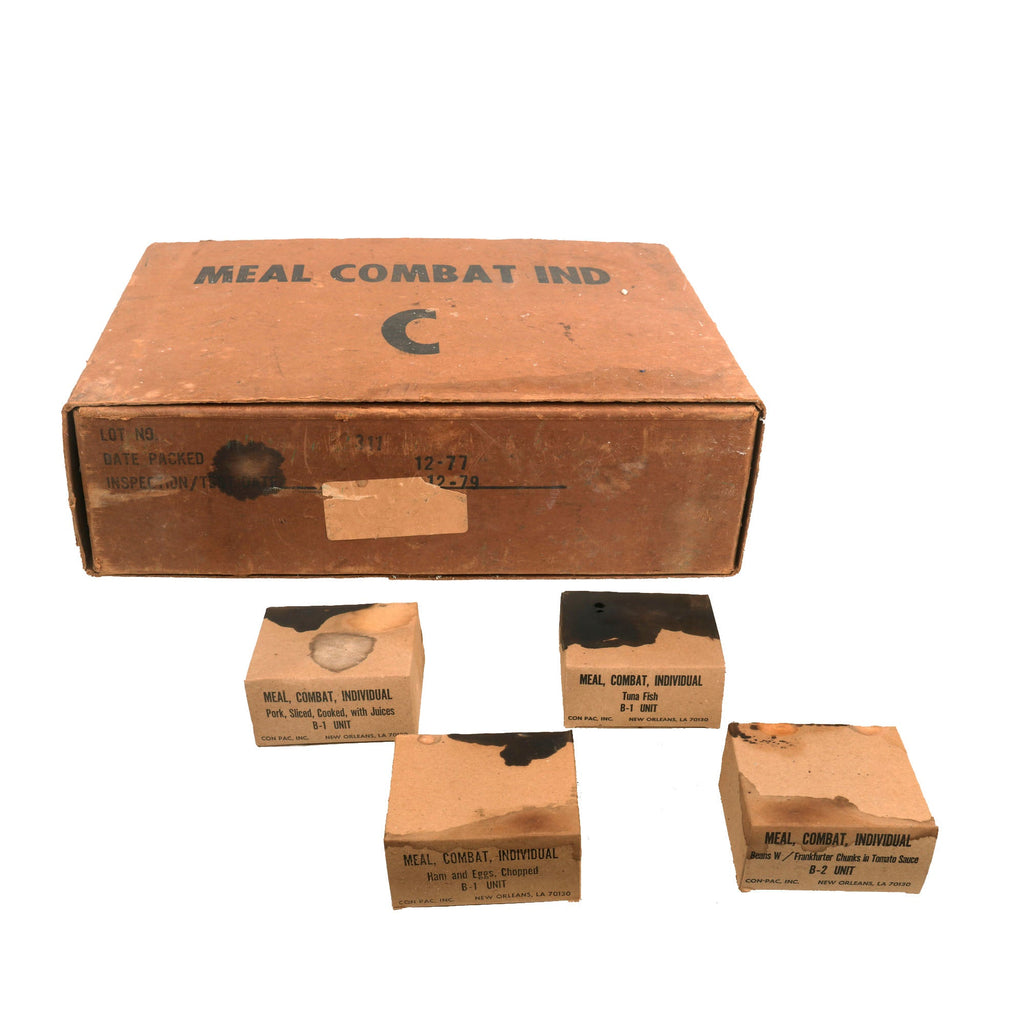Item Description
Original Item: Only One Available. Now this was a fantastic discovery! It’s not very often you come across a C-Ration case still filled. While the initial specification was officially declared obsolete in 1945, and production of all Type C rations ended in 1958, existing stockpiles of both original and revised Type C rations continued to be issued to troops serving in Korea and even as late as the Vietnam War. A Marine tank commander serving in Vietnam in 1968 noted his unit was frequently supplied with older stocks of C-rations, complete with early 1950s dates on the cans. With that being said, the contents inside are more than likely a decade older than the 1977 date stamped on the box.
As far as we can tell, all contents are still present inside of the cardboard box which was unfortunately opened by a novice collector some time ago, and measures 19" x 13" x 6".
This would be a wonderful addition to any Vietnam War era collections. Comes more than ready for further research and display.
Field ration, Type C (1938–1945)
The original Type C ration, commonly known as the C-ration, was intended to replace the Reserve Ration as a short-term individual ration designed for short use, to be supplemented by the D-ration emergency ration.
Development of a replacement for the Reserve Ration was undertaken by the newly formed Quartermaster Subsistence Research and Development Laboratory in Chicago in 1938 with the aim of producing a ration that was more palatable, nutritionally balanced, and had better keeping qualities.
The first C-ration consisted of a 16 ounces (450 g) 'meat' unit (M-unit) (reduced to 12 ounces (340 g) after being field tested during the 1940 Louisiana maneuvers). In the initial C-ration, there were only three variations of the main course: meat and beans, meat and potato hash, or meat and vegetable stew. Also issued was one bread-and-dessert can, or B-unit. Each daily ration (i.e. enough food for one soldier for one day) consisted of six 12 oz (340 g) cans (three M-units and three B-units), while an individual meal consisted of one M-unit and one B-unit. The original oblong can was replaced with the more common cylindrical design in June 1939 due to mass production problems with the former shape of can.
The 12 oz (340 g) C-ration can was about 4.4 inches (11 cm) tall and 3 inches (7.6 cm) in diameter. It was made of non-corrugated tinplate, had a visible tin solder seam, and incorporated an opening strip. A key for use on the opening strip was soldered to the base of every B unit can.
The first C-ration cans had an aluminized finish, but in late 1940, this was changed to a gold lacquer finish to improve corrosion resistance. There was noticeable variation in the depth of gold color in World War II vintage cans, because of the large number of suppliers involved. Late in the war this was changed to drab green paint, which remained standard through the remainder of the C-ration's service life, as well as that of the MCI.
During the war, soldiers frequently requested that the cylindrical cans be replaced with flat, rectangular ones (similar to a sardine can), comparable to those used in the earliest versions of contemporary K rations, because of their compactness and packability; but this was deemed impractical because of the shortage of commercial machinery available to produce rectangular cans. After 1942 the K ration too, reverted to the use of small round cans.
Initially, C-ration cans were marked only with paper labels, which soon fell off and made a guessing game out of evening meals; US Soldiers and Marines receiving an unpopular menu item several nights in a row often found themselves powerless to bargain for a more palatable one.
The C-ration was, in general, not well liked by U.S. Army or Marine forces in World War II, who found the cans heavy and cumbersome, and the menu monotonous after a short period of time. There were also inevitable problems with product consistency given the large number of suppliers involved and the pressures of wartime production. When issued to British or other Commonwealth forces formerly issued hardtack and bully beef-type rations, the C-ration was initially accepted, but monotony also became a chief complaint after a few days of consumption. Australian forces tended to dislike the C-ration, finding the canned food items generally bland, overly soft in texture, and unappealing. Originally intended only for infrequent use, the exigencies of combat sometimes forced supply authorities to make the C-ration the only source of sustenance for several weeks in succession. In 1943, a ration board reviewing medical examinations of soldiers after long-term use of C-rations recommended that they be restricted to a maximum of five continuous days in the absence of supplementation with other rations.
While the initial specification was officially declared obsolete in 1945, and production of all Type C rations ended in 1958, existing stockpiles of both original and revised Type C rations continued to be issued to troops serving in Korea and even as late as the Vietnam War. A Marine tank commander serving in Vietnam in 1968 noted his unit was frequently supplied with older stocks of C-rations, complete with early 1950s dates on the cans.
- This product is available for international shipping.
- Eligible for all payments - Visa, Mastercard, Discover, AMEX, Paypal & Sezzle
















